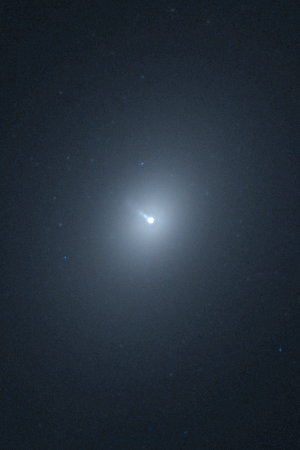History
Discovered by Lewis Swift on September 6, 1886, [5] NGC 1218 was one of the original objects included in the New General Catalogue. [6] 3C 78 was discovered c. 1957, and subsequently included in the Third Cambridge Catalogue of Radio Sources (3C). [7]
In 1982, it was found that the nucleus of NGC 1218 emits a radio jet. [8] A follow-up study in 1986 corroborated the presence of the jet, as well as finding evidence of a possible weak counter-jet. [9] The Hubble Space Telescope observed NGC 1218 on August 17, 1994. An optical jet of synchrotron radiation similar to that of Messier 87 was subsequently found. [10]
On September 6, 2000, a type Ia supernova was detected in NGC 1218. A 2002 study found that the previously identified radio jet was the cause. [11]
In 2023, the proper motion of 3C 78 was determined using observations from the Very Large Array (VLA), as well as a single observation from the Atacama Large Millimeter/submillimeter Array (ALMA). [12]
Composition and structure
NGC 1218 is a lenticular (S/0a) radio galaxy, with a radio halo roughly equivalent in size to the optical halo's extent. [8] The observable synchrotron jet has a total length of 1.37 arcseconds (0.75 kpc), and expands substantially at 0.5 arcseconds from the nucleus. [10]
NGC 1218 has an approximate hydrogen mass of <36×109 M☉. [9]
3C 78
3C 78 is an astronomical radio source with an angular extent of approximately 80 × 55 arcseconds squared. [9] According to Tabara and Inoue (1980), 3C 78 has a rotation measure of 8.7 ± 1.9 m−2 and an intrinsic position angle of 87° ± 4°, although Simard-Normandin, Kronberg, and Button (1981) claim that it has a rotation measure of 14 ± 2 m−2 and an intrinsic position angle of 85° ± 3°. [13] [14]
It possesses a radio jet approximately one arcsecond (0.58 kpc) in length, with three bright, compact inhomogeneities (or "knots"), with the second and thirds ones being the most prominent. The second knot has a longitudinal motion of approximately 0.51 ± 0.14c at roughly 200 pc, and the third knot had an apparent superluminal backwards motion of −2.6 ± 2c prior to 2000, followed by a forward motion of 0.5 ± 2c, both at roughly 300 pc. [12]
This page is based on this
Wikipedia article Text is available under the
CC BY-SA 4.0 license; additional terms may apply.
Images, videos and audio are available under their respective licenses.
